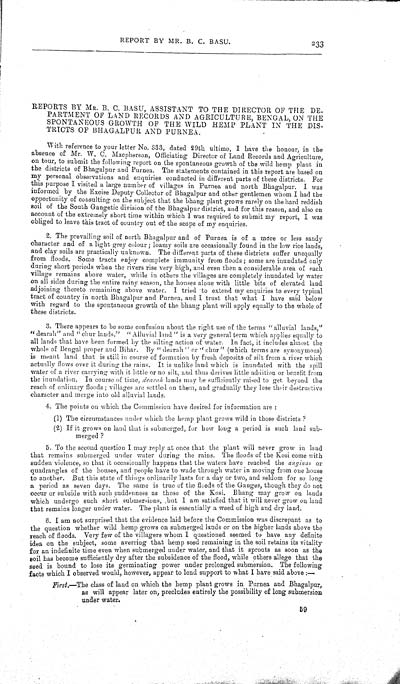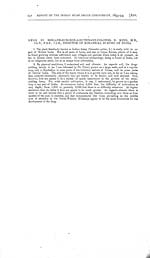Medicine - Drugs > Report of the Indian Hemp Drugs Commission, 1894-1895 > Volume III
(237) Volume 3, Page 233
Thumbnail gallery: Grid view | List view

REPORT BY MR. B. C. BASU. 233
REPORTS BY MR. B. C.
BASU, ASSISTANT TO THE DIRECTOR OF THE DE-
PARTMENT OF LAND RECORDS AND AGRICULTURE, BENGAL, ON THE
SPONTANEOUS GROWTH OF THE WILD HEMP PLANT IN THE DIS-
TRICTS OF BHAGALPUR AND PURNEA.
With reference to your
letter No. 333, dated 29th ultimo, I have the honour, in the
absence of Mr. W. C. Macpherson, Officiating Director of Land
Records and Agriculture,
on tour, to submit the following report on the spontaneous growth
of the wild hemp plant in
the districts of Bhagalpur and Purnea. The statements contained in
this report are based on
my personal observations and enquiries conducted in different parts
of these districts. For
this purpose I visited a large number of villages in Purnea and
north Bhagalpur. I was
informed by the Excise Deputy Collector of Bhagalpur and other
gentlemen whom I had the
opportunity of consulting on the subject that the bhang plant grows
rarely on the hard reddish
soil of the South Gangetic division of the Bhagalpur district, and
for this reason, and also on
account of the extremely short time within which I was required to
submit my report, I was
obliged to leave this tract of country out of the scope of my
enquiries.
2. The
prevailing soil of north Bhagalpur and of Purnea is of a more or
less sandy
character and of a light grey colour; loamy soils are occasionally
found in the low rice lands,
and clay soils are practically unknown. The different parts of
these districts suffer unequally
from floods. Some tracts enjoy complete immunity from floods; some
are inundated only
during short periods when the rivers rise very high, and even then
a considerable area of each
village remains above water, while in others the villages are
completely inundated by water
on all sides during the entire rainy season, the houses alone with
little bits of elevated land
adjoining thereto remaining above water. I tried to extend my
enquiries to every typical
tract of country in north Bhagalpur and Purnea, and I trust that
what I have said below
with regard to the spontaneous growth of the bhang plant will apply
equally to the whole of
these districts.
3. There appears to
be some confusion about the right use of the terms "alluvial
lands,"
"dearah" and " chur lands." "Alluvial land" is a very general term
which applies equally to
all lands that have been formed by the silting action of water. In
fact, it includes almost the
whole of Bengal proper and Bihar. By "dearah" or "chur" (which
terms are synonymous)
is meant land that is still in course of formation by fresh
deposits of silt from a river which
actually flows over it during the rains. It is unlike land which is
inundated with the spill
water of a river carrying with it little or no silt, and thus
derives little addition or benefit from
the inundation. In course of time, dearah lands may be
sufficiently raised to get beyond the
reach of ordinary floods; villages are settled on them, and
gradually they lose their destructive
character and merge into old alluvial lands.
4. The points on which the Commission have desired for information are:
(1) The circumstances under which the hemp plant grows wild in those districts ?
(2) If it
grows on land that is submerged, for how long a period is such land
sub-
merged ?
5. To the second
question I may reply at once that the plant will never grow in
land
that remains submerged under water during the rains. The floods of
the Kosi come with
sudden violence, so that it occasionally happens that the waters
have reached the angiuas or
quadrangles of the houses, and people have to wade through water in
moving from one house
to another. But this state of things ordinarily lasts for a day or
two, and seldom for so long
a period as seven days. The same is true of the floods of the
Ganges, though they do not
occur or subside with such suddenness as those of the Kosi. Bhang
may grow on lands
which undergo such short submersions, but I am satisfied that it
will never grow on land
that remains longer under water. The plant is essentially a weed of
high and dry land.
6. I am not
surprised that the evidence laid before the Commission was
discrepant as to
the question whether wild hemp grows on submerged lands or on the
higher lands above the
reach of floods. Very few of the villagers whom I questioned seemed
to have any definite
idea on the subject, some averring that hemp seed remaining in the
soil retains its vitality
for an indefinite time even when submerged under water, and that it
sprouts as soon as the
soil has become sufficiently dry after the subsidence of the flood,
while others allege that the
seed is bound to lose its germinating power under prolonged
submersion. The following
facts which I observed would, however, appear to lend support to
what I have said above:—
First.-The class of land
on which the hemp plant grows in Purnea and Bhagalpur,
as will appear later on, precludes entirely the possibility of long
submersion
under water.
59
Set display mode to: Large image | Zoom image | Transcription
Images and transcriptions on this page, including medium image downloads, may be used under the Creative Commons Attribution 4.0 International Licence unless otherwise stated. ![]()
| India Papers > Medicine - Drugs > Report of the Indian Hemp Drugs Commission, 1894-1895 > Volume III > (237) Volume 3, Page 233 |
|---|
| Description | Volume 3: Appendices. Miscellaneous. |
|---|---|
| Attribution and copyright: |
|




